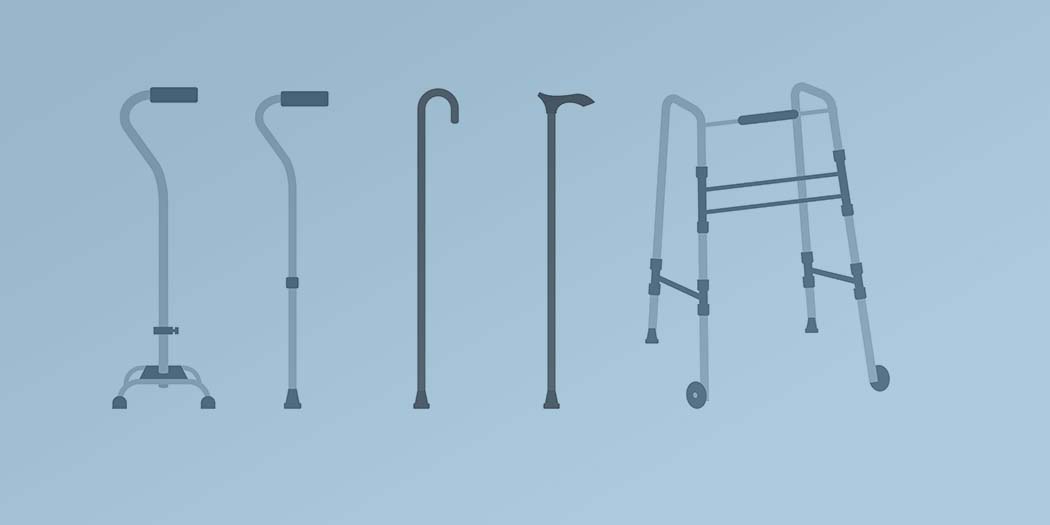Cane vs. Walker: What’s Right For You?
Our bones get more brittle as we get older, and our joints start to ache. This hinders our ability to walk and be mobile the way we once used to.
We have several options when it comes to increasing our mobility. These could range from canes to walkers to rollators and wheelchairs.
In this article, we talk about is it better to use a cane or a walker.
When Should You Use a Walking Aid Like a Walker or a Cane?
1) If you are at a high risk of falling (weak hips, pain in hips, etc.).
2) If you experience increased hip pain when walking (arthritis, etc.).
3) If you walk with a noticeable limp.
Assistive devices like canes and walkers help people who are weak or have balance problems walk more safely. They may also help some people avoid falls.
There are many different kinds of walking aids available, so it’s essential to work with a healthcare provider to choose the right type of walking support for you.
If you want to continue walking, the two broad category choices would be between a cane and a walker.
To choose the right one for you, you should understand the differences.
Here’s what you need to know about the differences between canes and walkers:
What Is a Walker?
Walkers are metal-framed devices specifically designed to give walking and balance support. They stand on their own because they have four feet.
Walkers don’t weigh much and they are easily movable, and many of them fold for easy storage. They are also adjustable in height to fit the person using them.
Types of Walkers
1. Standard Walker
These are basic walkers and the most easily found ones on the market. It has four wheels and a handlebar.
They work by the user picking them up and placing them down with each step. These walkers are best for providing stability and covering short distances when stability is a concern.

These walkers are best for people who have a fear of falling forward.
Most standard walkers fold for easy storage.
2. Front-Wheeled Walker
A two-wheeled rolling walker is another type of walker. This model is similar to the standard walker, except that there are two wheels, as the name indicates.
They have wheel casters on the front two legs and standard rubber tips on the back legs. The rolling walker is better for those who find it difficult to lift and move a standard walker.
The user of this walker puts their weight on the walker while walking. The wheels help move it forward. The rubber tips on the legs prevent the walker from sliding when put in place.
After a hip replacement or other hip-related operation, these types of walkers might be the safest way to get around (read more: How long do you use a walker after hip replacement).
You can choose to have the walker wheels inside or outside. When installed inside it’s easier to go through tight doorways and corridors, outside you have a wider base for stability.
3. Four-wheeled Walker
Four-wheeled walkers are called rollators. They are easiest to maneuver, as you don’t need to lift them up and down.
But on the other hand, it can be challenging to put your weight on them as they move by rolling along the floor. Some models feature a seat or breaks.
In many cases, four-wheeled walkers fold for easy transport on airplanes.
4. Upright Walker
When you compare an upright walker to a rollator, you see similarities since both have four wheels. But there are some significant differences.
On an upright walker, the handles are higher than those on a rollator, right below the elbow.
You do not have to lean forward when walking. Upright walkers promote a better posture.
What Is a Cane?
Canes are walking sticks that provide support, balance, and stability. They are also great devices that help with mobility post-surgery or during recovery from injuries.
You can choose from many different types, sizes, and even handles, depending on your preferences.
Types of Canes
1. Single Point
A single-point cane is your standard cane. It has a single-support point, usually fortified with a rubber tip for extra stability. Various materials and handles are available.
2. Quad Cane
Quad canes have four support points on the ground. They can stand on their own and provide the most support as far as canes are concerned. They are usually adjustable by height to suit the user.
3. Tripod Cane
Much like quad canes, these canes also have multiple support points. However, instead of four, they have three. They are also stand-alone but provide less support than quad canes.
4. Seated Cane
Seated canes are regular canes that have a special attachment to them. If the user walks for a long time and gets tired, this attachment can be set up as temporary seating.
When Choosing a Cane Grip, What Should I Consider?
The most popular grips are foam grips or grips that mold to your hand. It is best to use ergonomic grips if you have joint problems. Replacement grips are always easily available.
Should I Use a Cane or a Walker?
Canes and walkers both have their advantages and disadvantages.
The main difference is that a cane cannot offer the same STABILITY as a walker, but a walker cannot provide MOBILITY like a cane.
You might consider the following factors when choosing between a cane and a walker:
What Are Your Reasons for Getting the Mobility Device?
Walkers are generally better for conditions that affect both sides of the body, while canes are better if you have pain on one side (weakness in both your legs vs. pain in one leg).
Do You Need to Go Up and Down the Stairs?
As walkers are designed to be used on flat surfaces, a cane is better for going up and downstairs. Anyway, you need to learn how to use a cane safely, if you go to stairs with it.
How Much Support Do You Need?
A Standard single-tip cane doesn’t offer that much stability, but four-point quad canes provide more support for balance. Of course, walkers offer supreme balance compared to canes.
You may find that a walker provides better help if you are unsteady on your feet or have poor balance.
How Much of Your Body Weight Must the Device Accommodate?
While walking canes can typically support up to 25% of your body weight, some walkers can support up to 50%.
How Accessible Is Your Home?
If you use a walker, there might be some steps that you need to take to make a home easier to maneuver.
Rugs that are too thick can snag your walker. Doorways smaller than 34 inches can be difficult to pass through.
Ideally, people using walkers need a CLEAR PATH to move and turn around. A walking cane offers much more flexibility with this.
The Bottom Line
Walkers bear weight, unlike canes, so they provide support for those with more advanced BALANCE problems or stability issues.
If you have arthritis, osteoporosis, multiple sclerosis, Parkinson’s disease, or other conditions that make it difficult for you to walk without support, then a walker might be your best option.
However, if you just want to INCREASE your mobility, a cane might be more suitable. Canes offer a more accessible and portable option for walking.
If you have a higher risk of falling, a walker would be the better choice for you.
However, if in doubt, it is best to visit your medical practitioner and get their advice on a cane vs. walker before making any decisions.
Learn how to use the cane correctly here.
What if you can’t use a cane or walker safely anymore? If so, you will probably need to take a look at the different types of wheelchairs available.
P.S. When is it safe to transition from a walker to a cane?
You should consider switching to a cane when you don’t need that much support anymore, and your walker is getting in the way. If you use a cane, you should walk without leaning heavily on it. It is just a way to touch the ground.







